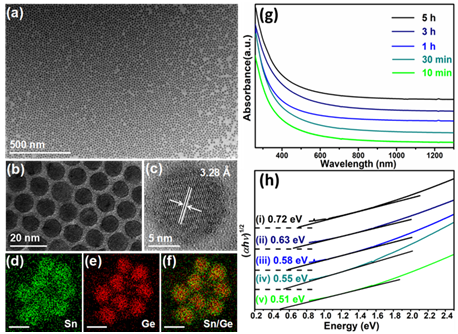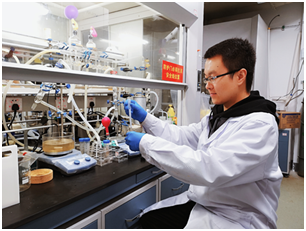Optoelectronic devices improve through undergraduate research
2019-03-28
Recently, Southern University of Science and Technology (SUSTech) 2015 undergraduate student Qi YANG published one paper in renowned journal Chemistry of Materials (IF = 9.9). The paper was titled “Facile Synthesis of Uniform Sn1–xGex Alloy Nanocrystals with Tunable Bandgap”.
Tin-germanium (Sn1–xGex) alloy nanocrystals (NCs) are the subject of intensive interests in the fields of electronic and optoelectronic devices, due to their tunable bandgap in near-infrared region and low-toxic property. However, high crystallization temperature of Ge and large lattice mismatch (~ 14 %), as well as low solubility (< 1 %) between Sn and Ge, make the synthesis high quality Sn1–xGex alloy NCs present many challenges. Over the past decade, various Sn-Ge materials have been synthesized through different strategies, such as pulsed laser melting, epitaxial growth, and solution-based method. However, it also suffers from some issues such as poor structure/morphology control and complicated synthesis process.

Herein, we report a facile and mild method to synthesize uniform semi-conductive Sn1-xGex alloy NCs with tunable bandgap (0.51 eV to 0.72 eV) obtained from the method of Tauc plot, based on the controlled reaction of Ge2 precursor solution with uniform Sn NCs as the template. Comparing with previously reported methods to synthesize phase pure Sn1-xGex alloy NCs (above 300 oC), it should be noted that the formation of Sn1-xGex alloy NCs through our method can occur at a temperature as low as 90 oC. The reason can be ascribed to the unique catalytic effect of Sn NCs on the decrease of activation energy barrier for nucleation, crystallization and growth of Sn1-xGex alloys. The formation process of Sn1-xGex alloy NCs is also detailedly revealed as an evolution from heterogeneous core-shell structure to homogeneous alloy structure based on the redox reaction and solid diffusion mechanisms.
The research work was supported by a number of funds, including the National Natural Science Foundation of China, Shenzhen Science and Technology Innovation Committee, Development and Reform Commission of Shenzhen Municipality (Novel Nanomaterial Discipline Construction Plan), start-up fund and Presidential fund from SUSTech, and the Special Funds for the Cultivation of Guangdong College Students’ Scientific and Technological Innovation. (“Climbing Program” Special Funds).

Qi YANG admitted that he was not an excellent student at first, and struggled to find direction. With the poor morale and confusion for his future, he met Quan Zewei within an experimental course on principles of chemistry. This saw Yang Qi resolve to find his love for chemistry and confidence, so he emailed Quan Zewei in wishing to join his research group. Ever since his freshman summer vacation, Yang Qi has succeeded a new-found love and perseverance for scientific research and exploration.
For this paper, the research team spent a significant amount of time overhauling their paper, with lots of feedback from peer reviewers which required two rounds of review over six months before the paper was finally approved. One new project has been made great progress, and Qi aims to finish before graduation. Yang Qi plans to go to Binghamton University, known as one of the Public Ivies, to pursue his PhD in Chemistry
Qi hopes that his classmates with low GPA can regain their self-confidence, and remember to persevere so they can find their own success as soon as possible.
Links: https://pubs.acs.org.ccindex.cn/doi/10.1021/acs.chemmater.8b04153




